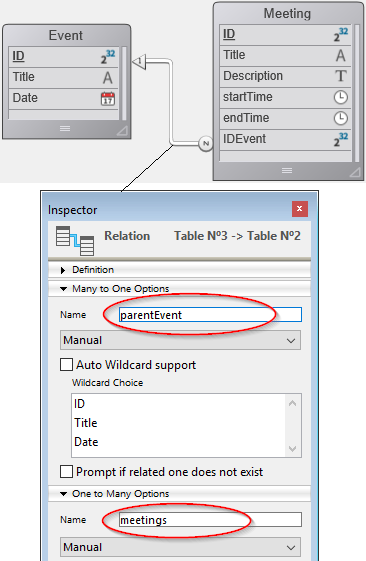This
This : Object
| Parameter | Type | Description | |
|---|---|---|---|
| Function result | Object | ← | Current element or object |
Description
The This command returns a reference to the currently processed object.
In most cases, the value of This is determined by how a function is called. It can't be set by assignment during execution, and it may be different each time the function is called.
This command can be used in different contexts, described below. Within these contexts, you will access object/collection element properties or entity attributes through This.<propertyPath>. For example, This.name or This.employer.lastName are valid pathes to object, element or entity properties.
In any other context, the command returns Null.
Class function
When a class constructor function is used (with the new() function), its This is bound to the new object being constructed.
//Class: ob
Class constructor
// Create properties on This as
// desired by assigning to them
This.a:=42
// in a 4D method
$o:=cs.ob.new()
$val:=$o.a //42
When calling the superclass constructor in a constructor using the Super keyword, keep in mind that
Thismust not be called before the superclass constructor, otherwise an error is generated. See this example.
In any cases, This refers to the object the method was called on, as if the method were on the object.
//Class: ob
Function f() : Integer
return This.a+This.b
Then you can write in a project method:
$o:=cs.ob.new()
$o.a:=5
$o.b:=3
$val:=$o.f() //8
In this example, the object assigned to the variable $o doesn't have its own f property, it inherits it from its class. Since f is called as a method of $o, its This refers to $o.
Formula object
In the context of the execution of a formula object created by the Formula or Formula from string commands, This returns a reference to the object currently processed by the formula.
For example, you want to use a project method as a formula encapsulated in an object:
var $person : Object := New object
$person.firstName:="John"
$person.lastName:="Smith"
$person.greeting:=Formula(Greeting)
$g:=$person.greeting("hello") // returns "hello John Smith"
$g:=$person.greeting("hi") // returns "hi John Smith"
With the Greeting project method:
#DECLARE($greeting : Text) : Text
return $greeting+" "+This.firstName+" "+This.lastName
List box
In the context of a list box associated to a collection or an entity selection, during the On Display Detail or the On Data Change events, This returns a reference to the collection element or entity accessed by the list box to display the current row.
If you use a collection of scalar values in a list box, 4D creates an object for each element with a single value property. Thus, the element value is returned by the This.value non-assignable expression.
Example 1
A collection of objects, each with this structure:
{
"ID": 1234
"name": "Xavier",
"revenues": 47300,
"employees": [
"Allan",
"Bob",
"Charlie"
]
},{
"ID": 2563
"name": "Carla",
"revenues": 55000,
"isFemale": true
"employees": [
"Igor",
"Jane"
]
},...
In the list box, each column refers to one of the properties of the object, either directly (This.name), indirectly (This.employees.length), or through an expression (getPicture) in which can be used directly. The list box looks like:
The GetPicture project method is automatically executed during the On display detail event:
//GetPicture Method
#DECLARE -> $genderPict : Picture
If(This.isFemale)
$genderPict:=Form.genericFemaleImage
Else
$genderPict:=Form.genericMaleImage
End if
Once the form is executed, you can see the result:

Example 2
You want to display entities from the following structure in a list box:

You build a list box of the "Collection or entity selection" type with the following definition:

Note that:
- This.ID, This.Title and This.Date directly refers to the corresponding attributes in the ds.Event dataclass.
- This.meetings is a related attribute (based upon the One To Many relation name) that returns an entity selection of the ds.Meeting dataclass.
- Form.eventList is the entity selection that is attached to the list box. The initialization code can be put in the on load form event:
Case of
:(Form event code=On Load)
Form.eventList:=ds.Event.all() //returns an entity selection with all entities
End case
Once the form is executed, the list box is automatically filled with the entity selection:
See also
Properties
| Command number | 1470 |
| Thread safe | yes |